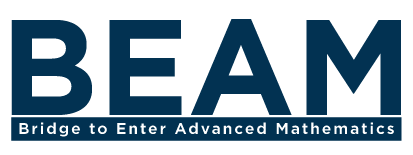When we ask BEAM 7 students what they see themselves doing as an adult at the beginning of the summer and then again at the end, their replies are always all over the map. Oftentimes answers change from one end of the summer to the other, and it can be hard to read from their response how their experiences at BEAM might have shaped the careers that they see for themselves in the future.
For example, mathematician is the only career that appears on both of Karen’s lists from before and after the summer; her responses seem to point towards a settled desire to pursue math. Meanwhile Amara only includes mathematician on his list at the end of the summer, hinting at a dramatic discovery of math. But their actual stories are more complicated, and at the same time richer: more reflective of what it really means and how it really feels to encounter advanced mathematics.
Amara doing a scavenger hunt, code-breaking activity.
Even though mathematician doesn’t appear among the careers that Amara can see himself pursuing before BEAM 7, his words on our opening survey already read like those of a budding mathematician.
I hope I become better and I want to achieve to become more of a person who likes challenge.
And when he writes about working on a math problem for days, it is clear that he is pressing towards that goal of embracing the struggle that comes with mathematics: It was so frustrating, but I never gave up.
John Urschel, former pro-football player and math PhD student at MIT, had something similar to say about his own earlier encounters with mathematics: It was so hard... And it was a struggle that I really loved.
Amara’s journey over the summer touches on a theme that is common to the study of advanced mathematics. Success in mathematics often means learning to love not just the mathematics, but also the toil that comes with it.
By the end of the summer, when we ask Amara what he likes about math, his response is a single word, one that captures the precise sentiments of many seasoned mathematicians: Challenging.
Karen folding origami.
On the other hand, Karen brought her desire to be a mathematician with her to BEAM and her goal to pursue mathematics did not waiver throughout the program. However, she did learn more about how it feels to pursue challenging mathematics, and the kind of community you want to have in your corner as you tackle difficult math problems.
This is what Karen had to say about what she learned at BEAM:
People aren’t really how you would think they are. There will always be someone with their arms wide open to pour feelings out to.
The larger mathematical community isn’t always a supportive one, especially for students of color. BEAM is out to change that, and we aren’t alone. Mathematicians of the highest caliber are beginning to recognize that humanity along with all her children, their history, their hurts and highest hopes, have a place in the midst of math. In the words of Francis Su, former president of the Mathematical Association of America and math professor at Harvey Mudd:
Math doesn’t happen in a vacuum, devoid of feeling or emotion. As Karen wrote about her experience working on a math problem for days: It was stressful, but after solving it I was satisfied.
Pursuing math is stressful! It is satisfying and rewarding and beautiful, but also (and often) stressful. The stress and the struggle are necessary aspects of pursuing math, worthy aspects of expanding the mathematical frontier. But the struggle doesn’t have to be a lonely one.
Every mathematician needs a shoulder to cry on from time to time, and that is what Karen found at BEAM, a community she can count on.
Only time will tell whether Karen and Amara choose to pursue being a mathematician as a future career, but they have already encountered currents that can carry them to the very heart of mathematics: the exhilarating joy of struggle and the strength of a supportive and understanding math community.



